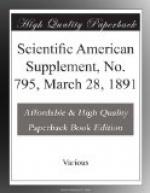The bones of chickens fed upon a nitrogenous ration are fifty per cent. stronger than those fed upon a carbonaceous ration.
Hens fed on a nitrogenous ration lay many more eggs but of smaller size and poorer quality than those fed exclusively on corn.
Hens fed on corn, while not suffering in general health, become sluggish, deposit large masses of fat on the internal organs, and lay a few eggs of large size and excellent quality.
The flesh of nitrogenous fed fowls contains more albuminoids and less fat than those fed on a carbonaceous ration, and is darker colored, juicier and tenderer.
I.P. ROBERTS, Director.
* * * * *
HERBACEOUS GRAFTING.
My attention has been called a number of times to the unsatisfactory records and directions concerning the grafting of herbaceous plants. There appears to have been very little attention given to the subject, and the scant discussions of it are mostly copied from one author to another. A few years ago I made some attempts at herbaceous grafting, but it was not until last winter that experiments were seriously undertaken. The work was put in the hands of J.R. Lochary as a subject for a graduating thesis.
The experiments were undertaken primarily for the purpose of learning the best methods of grafting herbs, but a secondary and more important object was the study of the reciprocal influences of stock and cion, particularly in relation to variegation and coloration. This second feature of the work is still under way, in one form or another, and we hope for definite results in a few years. As a matter of immediate advantage, however, herbaceous grafting has its uses, particularly in securing different kinds of foliage and flowers upon the same plant. There is no difficulty in growing a half dozen kinds or colors, on geraniums, chrysanthemums, or other plants from one stock of the respective species.
Six hundred grafts were made in our trials last winter. It was found that the wood must be somewhat hardened to secure best results. The very soft and flabby shoots are likely to be injured in the operation of grafting, and union does not take place readily. Vigorous coleus stocks, three months old, gave best results if cut to within two or three inches of the pot and all or nearly all the leaves removed from the stump. Geraniums, being harder in wood, made good unions at almost any place except on the soft growing points. The stock must not have ceased growth, however. Most of the leaves should be kept down on the stock. Cions an inch or two long were usually taken from firm growing tips, in essentially the same manner as in the making of cuttings. Sometimes an eye of the old wood was used, and in most cases union took place and a new shoot arose from the bud. The leaves were usually partly removed from the cion.




